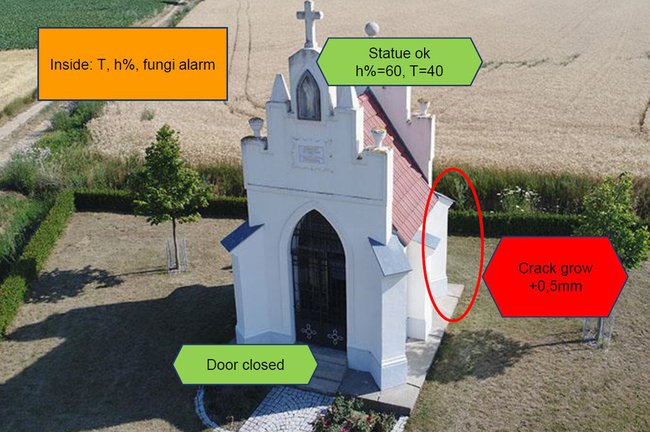Visual Sensor Data Protects Cultural Artefacts
A Project by the St. Pölten UAS Renders Sensor Data Visible on the Smartphone with the Aim to Preserve Cultural Heritage.

The research project “Datascope”, which is coordinated by the St. Pölten University of Applied Sciences, uses augmented reality to make invisible environmental data visible for humans. Researchers develop mobile data visualisation methods integrated into real-life surroundings to combine the physical environment with abstract data representations.
For one of the project’s use cases, the researchers explore how this method can help protect cultural heritage. It can contribute to preserving historical buildings or assessing the state of a building after an earthquake.
Augmented Perspective Thanks to Sensors
Similar to a microscope, which renders things visible that are too small, or a telescope, which lets us see things that are too far away, the project “Datascope” aims at making inherently invisible data visible in their real environment. Location-based environmental data are captured by sensors and subsequently displayed. Potential application areas are disaster protection, agriculture, viticulture, drinking water supply, and winter road maintenance.
One of the use cases is dedicated to the protection of cultural heritage. The datascope team is currently collecting ideas on how to use sensors and sensor visualisation for the monitoring and conservation of historical sites and objects. Sensors could capture various data on the state of buildings such as humidity, cracks in walls, tremors, vibrations and breakage of glass.
“In our work, we face challenges such as security and data protection, the lack of common tools and a shared terminology in the field of data visualisation, and the identification of those in charge of the sites and objects”, says Wolfgang Aigner, the project coordinator and Head of the St. Pölten UAS’ Institute of Creative\Media/Technologies.
Reconstruction Help after Earthquakes
Headed by the University for Continuing Education Krems, the interdisciplinary “School of Reconstruction” in Accumoli (Italy) has great potential for collaboration with the project. Since the occurrence of a series of earthquakes in Central Italy in 2016 and 2017, a number of universities and research institutions have dedicated teaching and research activities to issues surrounding the reconstruction of destroyed cities. Next to the earthquake-proof reconstruction of historical buildings, the project seeks to address the sustainable reactivation of economic, social, cultural and religious structures.
“In Accumoli, we have the ideal conditions for testing the sensors which were developed in the project, LPWAN communication technology, and the sensor data visualisation. We expect significant results on the feasibility and improvement of monitoring and preserving of cultural artefacts and buildings through digitalisation”, says Albert Treytl, Head of the Center for Distributed Systems and Sensor Networks of the University for Continuing Education Krems.
Further Steps
In a further step, the ideas, potential areas of application, and identified challenges that were collected during project workshops will be applied to the design of useful tech demos to support experts in the field. In addition, the Datascope team will develop and evaluate new technologies for the visualisation of location-based environmental data.
Further use cases of the project include a test installation of a disinfectant dispensers in the buildings of the University for Continuing Education Krems, where sensors in the dispensers measure the battery levels and low levels of disinfectant liquids, and an IT security testbed, which was installed to identify weak spots in an LoRaWAN network at the St. Pölten UAS.
Strengthening Digital Development in Lower Austria
Within the framework of the project, the St. Pölten UAS collaborates with the IMC University of Applied Sciences Krems, with FOTEC Forschungs- und Technologietransfer GmbH in Wiener Neustadt, and the Department for Integrated Sensor Systems of the University for Continuing Education Krems, also located in Wiener Neustadt. “This project helps us to strengthen the digital further development of Lower Austria”, says Aigner.
Project Datascope
The project is subsidised by the Province of Lower Austria within the framework of the research, technology and innovation strategy (FTI-Strategie).
